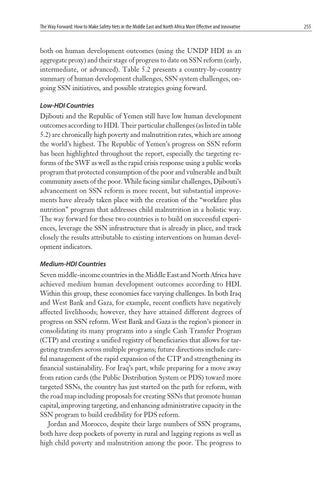254
Inclusion and Resilience: The Way Forward for Social Safety Nets in the Middle East and North Africa
The Way Forward: How to Make Safety Nets in the Middle East and North Africa More Effective and Innovative
• In countries under increasing fiscal pressure from subsidies, implementing internal reforms in this system or wholesale reforms focused on less-sensitive products, gradually introducing these changes while building credibility.
both on human development outcomes (using the UNDP HDI as an aggregate proxy) and their stage of progress to date on SSN reform (early, intermediate, or advanced). Table 5.2 presents a country-by-country summary of human development challenges, SSN system challenges, ongoing SSN initiatives, and possible strategies going forward.
In the medium run, the focus can shift to reforms that require more preexisting capacity, such as refining the SSN infrastructure and comprehensive subsidy reform. This second-generation set of reforms can entail • Sharpening the focus on results in SSN programs through M&E and social accountability, reaching out to other stakeholders in financing and implementation, and strengthening administrative capacity among relevant institutions; • Consolidating existing fragmented safety net programs for more effectiveness and results, thereby reducing overlaps and bridging coverage gaps; and • Launching wholesale subsidy reforms.
Country-by-Country Summary and Strategies Countries in the Middle East and North Africa find themselves at different stages of progress on human development outcomes and SSN reforms. Table 5.1 presents an overview of the achievements in the region,
TABLE 5.1
Progress on Human Development Outcomes and SSN Reform, by Stage, in the Middle East and North Africa, 2011 SSN reform HDI level Low HDI Medium HDI
Advanced stage Yemen, Rep. West Bank and Gaza
High to very high HDI
Intermediate stage Djibouti Jordan Morocco
Bahrain Lebanon
Early stage Algeria Egypt, Arab Rep. Iraq Syrian Arab Republic Kuwait Oman Qatar Saudi Arabia Tunisia United Arab Emirates
Source: Authors using UNDP 2011 data for HDI. Note: Libya and the Islamic Republic of Iran are not included due to insufficient data. HDI = Human Development Index (of the United Nations Development Programme); SSN = social safety net.
Low-HDI Countries Djibouti and the Republic of Yemen still have low human development outcomes according to HDI. Their particular challenges (as listed in table 5.2) are chronically high poverty and malnutrition rates, which are among the world’s highest. The Republic of Yemen’s progress on SSN reform has been highlighted throughout the report, especially the targeting reforms of the SWF as well as the rapid crisis response using a public works program that protected consumption of the poor and vulnerable and built community assets of the poor. While facing similar challenges, Djibouti’s advancement on SSN reform is more recent, but substantial improvements have already taken place with the creation of the “workfare plus nutrition” program that addresses child malnutrition in a holistic way. The way forward for these two countries is to build on successful experiences, leverage the SSN infrastructure that is already in place, and track closely the results attributable to existing interventions on human development indicators.
Medium-HDI Countries Seven middle-income countries in the Middle East and North Africa have achieved medium human development outcomes according to HDI. Within this group, these economies face varying challenges. In both Iraq and West Bank and Gaza, for example, recent conflicts have negatively affected livelihoods; however, they have attained different degrees of progress on SSN reform. West Bank and Gaza is the region’s pioneer in consolidating its many programs into a single Cash Transfer Program (CTP) and creating a unified registry of beneficiaries that allows for targeting transfers across multiple programs; future directions include careful management of the rapid expansion of the CTP and strengthening its financial sustainability. For Iraq’s part, while preparing for a move away from ration cards (the Public Distribution System or PDS) toward more targeted SSNs, the country has just started on the path for reform, with the road map including proposals for creating SSNs that promote human capital, improving targeting, and enhancing administrative capacity in the SSN program to build credibility for PDS reform. Jordan and Morocco, despite their large numbers of SSN programs, both have deep pockets of poverty in rural and lagging regions as well as high child poverty and malnutrition among the poor. The progress to
255
